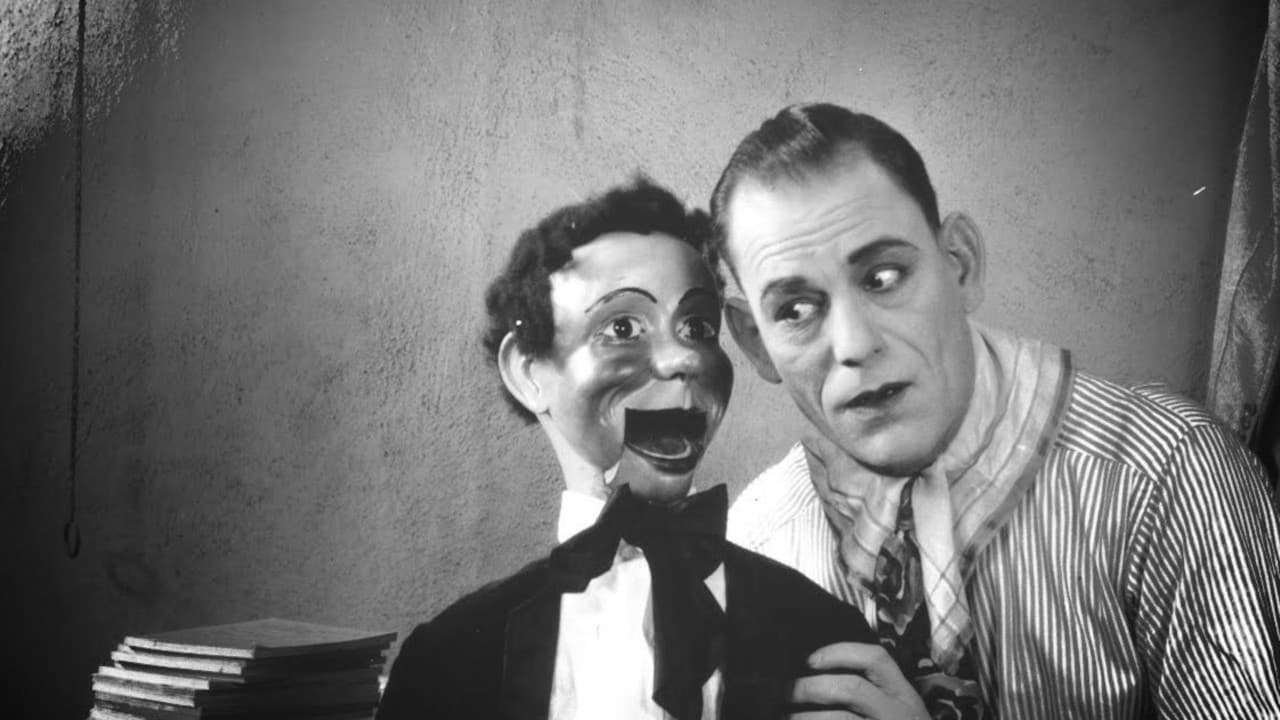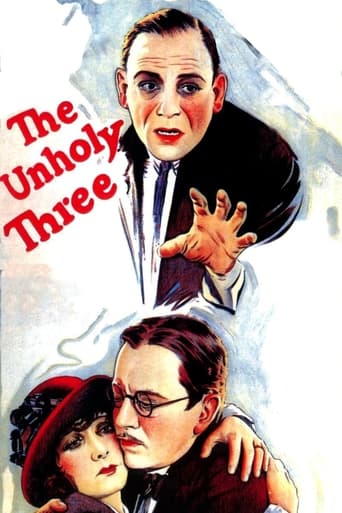


Lon Chaney known as the man of a thousand faces usually reserved those faces for some grotesque character or monster to which he brought his considerable acting talents to create sympathy. The Unholy Three is an unusual film because he's quite an ordinary man here, but he effects the disguise of an old woman for criminal purposes.Due to some light fingered activity at a carnival he was employed at Chaney, strong man Victor McLaglen, and midget Harry Earles find themselves unemployed. Chaney who is a ventriloquist decides that the three with their unique physical characteristics and talents can be used to create a nice criminal gang. Chaney in fact goes incognito in the guise of an old woman and Earles plays her grand baby. Personally I think he was way too big to be a toddler, but that's a little dramatic license that director Todd Browning was taking.Chaney also buys a pet shop and Mae Busch who was a carnival waif goes and lives with them. They also employ Matt Moore as a salesman who is totally clueless about Chaney's and Earles's real identity and what they really do.Things go wrong and a murder is committed on a job Chaney could not go along on. That sets the rest of the story in motion.Of course Chaney's guise as an old woman is an astounding success as were all the other characters he created. Yet all the makeup and special effects would be for naught had he not had the acting chops to make it real.Saying that and saying that because Chaney's virtuosity dominates the film. I thought the ending was truly a cop out. It dulls the impact of Chaney's artistry and it was quite a let down in a film I was ready to rate a notch or two higher.Still his legion of fans will be well satisfied with this silent version of The Unholy Three remade by MGM for sound, Chaney's one and only sound feature.
... View MoreI had an afternoon free so I decided to watch the two versions of this Lon Chaney classic back to back, beginning with this one -- Tod Browning's silent original. It's the story of a crooked carnival ventriloquist (Lon Chaney) who teams up with the midget (Harry Earles) and strong man (Victor McLaglen ) for a series of robberies. Chaney dresses as an old woman and Earles plays a baby to perfect their scheme. In many ways this was a precursor to the popular Little Rascals/Our Gang short subject FREE EATS, where a couple of gangsters act as parents to a couple of little people dressed as infants, mistakenly referred to as "fidgets".Whether it's the silent version or sound remake, I thought this was a wildly entertaining story either way, though it's difficult to fairly judge one film or the other when they're viewed together so closely like this. There are pros and cons to both movies for me. The strength of Browning's silent version was that in many ways it felt much more stylish and better crafted, possibly with better production values... but I found I preferred Lila Lee as Rosie O'Grady (from the sound version) to the silent actress here, Mae Busch. The 1925 original perhaps feels a little too long, which is the only thing which kept it from being perfect for me. I wouldn't be surprised, though, if most fans prefer the silent film simply because it was directed by Tod Browning. My advice is to see them both! ***1/2 out of ****
... View MoreLon Chaney was one of the greatest actors who ever lived. He expresses more emotion in this movie with his facial expressions than many of the actors today can do with their voices. Chaney stars as Professor Echo,a sleazy carnival ventriloquist, who plans to pull off a crime that would make him and his two counterparts rich. Echo a master of voices will pose as an old lady, the sideshow midget named Tweedledee will be the baby, and Hercules the strongman will be a bystander. Together this team of unholy individuals open up a pet store which specializes in selling talking parrots. These birds talk and sing in the store but when the buyer brings them home they stop.A rich man named Arlington buys a parrot and calls "Old Lady Mcgrady" to come have a look at it. Tweedledee notices a red ruby necklace."Don't worry Grannie will buy you a nice set of red pearls like that" Echo's girlfriend Rosie is falling in love with Hector the employee at the store. Echo is beginning to lose his concentration and his partners plot against him. Hercules murders Arlington and after Hector proposes to Rosie Echo plans to frame him for the murder.Yes the plot is a bit silly at times but Chaney and his cast tell it with the utmost sincerity. Chaney's Echo is a sad character,not necessarily evil but selfish. His love for Rosie redeems him and his evil ways at the end of the movie. Chaney is one of the greats. He creates a vivid character. Man of a Thousand Faces is the correct title for him but here he doesn't need his make-up to create a face just his perfect acting skills.10/10
... View More"The Unholy Three" has the thinnest plot imaginable. Professor Echo's plan, which he claims will make them a million, revolves around selling parrots to rich people. Prof. Echo, a ventriloquist, throws his voice to make the purchasers believe the parrots are great talkers. When they complain that their birds are not talking any more he visits them at their homes with a baby in a pram ("Tweedledum" the midget) and checks what they have to steal. Luckily rich people seem to spend their time openly admiring their gems with the safe open.And that's the plot in a nutshell. A very dull film indeed. Not even Tod Browning's direction can get around the numbing limitations of the plot.
... View More